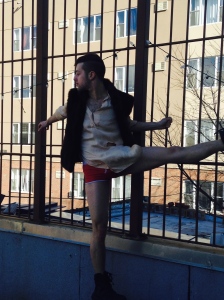Julia Meyer will be presenting her work Titled “Point-Blank” on Saturday, May 16th. Read on to learn more about her work!
Choreographer’s bio:
Julia graduated from Bard College in the spring of 2014 with a BA in dance and anthropology. Originally from St. Louis, MO, Julia has been studying dance since the age of three at COCA in University City. She continued her training at Bard College where she studied under renowned artists, including, Vanessa Anspaugh, Asli Bubul, Leah Cox, Faye Dricoll, Juliette Mapp, Paul Matteson, Jennifer Nugent, Stuart Singer, Nicole Smith, Daniel Squire, Mellissa Toogood, and Jesse Zarritt. Here, she developed her voice as both a dancer and choreographer, collaborating with her dancers to create movement that falls outside the pedestrian, yet remains human in the most peculiar and sometimes virtuosic ways. Along with dancing, Julia has experience in the visual arts, particularly painting, drawing, and printmaking. Her education in anthropology and studio art greatly inform her choreography—as she situate her work inside of visual installations allowing her dances to become spaces in themselves.
Dancer Bio
Jeremy Busch is a recent graduate of Vassar College, where he attained Bachelor of the
Arts degrees in Drama and Psychology, and was a member of the Vassar Repertory
Dance Theatre, a transformative experience that led him to ZviDance. Jeremy
credits the beginning of his serious training to Stacie Webster and Dawn Hillen,
esteemed teachers at Broadway Dance Center in New York City. In VRDT, former ABT
principal John Meehan, Martha Graham notable Steve Rooks, and the incomparable
Kathy Wildberger all contributed to Jeremy’s ongoing dance education. He’s
performed the works of Brian Reeder, Stephen Petronio, Larry Keigwin (including
the world premier of “Take Off”) and, most fortuitously, “Chairs,” by Zvi
Gotheiner with whom he is now an apprentice for. Jeremy is humbled and so
thankful for this opportunity.
Why is it important to present work in progress?
For me it’s extremely important to present work in progress. It’s a way to step outside of my own head, hear what other people are seeing and how they are interpreting the movement in front of them. This can be an important opportunity to step back, edit, and clarify anything that has been misinterpreted. But even more so I’ve found that hearing the thoughts of an external audience can take the work to a new, unexpected place. It allows me to see elements of my work that I was previously blind to, and creates new potential as to where the piece may end up.
Who are the most rewarding dancers for you to work with and why?
The most rewarding dancers are those who know the potential of their own physicality. They’ve discovered the range of their movement and are eager to discover possibilities that fall outside what they already know. A really great dancer can understand the movement that you are seeking to describe, but the best dancer will come up with something completely outside of what you ever imagined, and end up having more of an influence on the work that you create than you could have ever anticipated. I’ve worked with some really great dancers in my life and in these moments I believe that the work is just as much (if not more) theirs than it is my own.
Why is it important to present this piece of choreography to audiences in NYC?
For me, Point-Blank has multiple layers, and while it is descriptive of events that can and do transpire in any metropolis, on a more personal level, the impetus of this work took place in New York City. We tend to think that we’ve come a long way in terms of woman’s rights since the 1950s. And while I greatly enjoy my ability to wear pants, I still find myself wondering how far we’ve come. Especially when it’s impossible to walk down the street without being harassed. As a woman, I never think tell men to “smile” when they’re walking down the street, and frankly I don’t care if they do. So why is it, in a city that is very difficult to live in, in a city full of just as much stress and disappointment as possibility, am I always expected to always have a smile on my face?
The piece began with my decision to work at a private lap dance party in lower Manhattan. I found myself slightly transfixed with the amount of money I could make, and the amount of power that came with it. But after a while it takes its toll on you. Eventually I realized that I didn’t have as much power as I thought, and that management was not on my side, because well, management was run by men. This is the first piece that I’ve made that comes from a place of emotion above an analytical framework. It’s performed by a man to reach a slightly broader audience and it’s performed by a man because it’s not only about women’s rights but about how the body unravels in times of stress. It has to be performed in New York because New York is the city that birthed this ugly beast.
What should HATCH audiences look forward to in your work?
Right now the piece is a 10 minute solo and I think it has the potential to go further. I’m toying with the idea of adding additional dancers and turning it into a sight specific work (a subway platform or crowded street corner could be the next stage). I’m excited to see where it goes.

